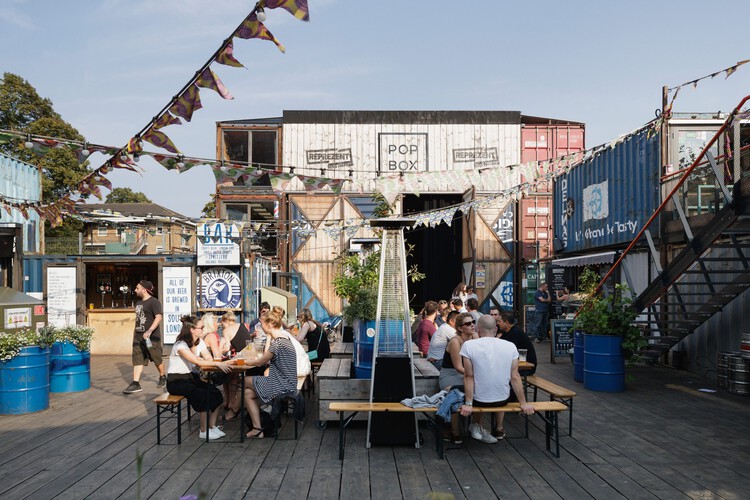How has Pop Brixton transformed a disused plot of land in Brixton, South London?
Located in the heart of London, UK, Pop Brixton and Peckham Levels are two innovative urban spaces that have transformed underutilized areas into vibrant community hubs. These spaces have not only revitalized the surrounding neighborhoods but have also provided opportunities for local businesses, artists, and entrepreneurs to thrive. Let’s take a closer look at how these urban spaces have unlocked the potential of their surroundings and inspired positive change.
Pop Brixton: A Creative Community Hub
Pop Brixton is a pioneering project that has given new life to a previously disused plot of land in Brixton, South London. This innovative space is home to a diverse community of independent businesses, start-ups, creative enterprises, and social enterprises. Its mission is to provide affordable workspace, support local entrepreneurship, and foster creativity and collaboration.
One of the main features of Pop Brixton is its use of recycled shipping containers, which have been repurposed to create small shop units, workspaces, and communal areas. This approach not only reduces construction costs but also provides a sustainable and eco-friendly solution for urban redevelopment.
Key Features of Pop Brixton:
- Community-focused design: Pop Brixton was designed with the local community in mind, and its layout encourages interaction and collaboration among its residents and visitors.
- Event spaces and communal areas: The venue hosts a wide range of events, workshops, and entertainment, making it a vibrant cultural hub for the neighborhood.
- Support for local businesses: Pop Brixton provides a platform for local businesses to showcase their products and services, helping them to grow and thrive.
Peckham Levels: A Multi-Purpose Creative Space
Located in the heart of Peckham, South London, Peckham Levels is a bold and ambitious project that has transformed a derelict multi-story car park into a dynamic and multifaceted cultural destination. This innovative project provides affordable, flexible, and inspiring workspace for artists, makers, and entrepreneurs, as well as a wide range of community-focused activities and events.
Key Features of Peckham Levels:
- Affordable workspace: Peckham Levels offers affordable studio spaces and co-working areas, providing a supportive environment for creative professionals and small businesses.
- Community engagement: The project has a strong focus on community engagement, with a wide range of workshops, events, and activities that bring people together and foster collaboration.
- Cultural programming: Peckham Levels provides a platform for emerging artists, musicians, performers, and cultural organizations to showcase their work and engage with the local community.
Lessons Learned and Inspiring Takeaways
The success of Pop Brixton and Peckham Levels can be attributed to several key factors, including community engagement, creative design, and a strong emphasis on supporting local businesses and entrepreneurs. These urban spaces have demonstrated the potential for underutilized areas to be transformed into vibrant and thriving community hubs, and they offer inspiring lessons for cities and neighborhoods looking to unlock the potential of their urban environments.
Key Takeaways:
- Community engagement: By actively involving the local community in the design and programming of urban spaces, it is possible to create inclusive and vibrant spaces that meet the needs of the residents.
- Supporting local businesses: Providing affordable workspace, retail opportunities, and support services for local entrepreneurs and small businesses can help to stimulate economic growth and cultural vitality.
- Creative design solutions: Innovative design approaches, such as repurposing shipping containers or transforming underused buildings, can provide sustainable and cost-effective solutions for urban redevelopment.
Pop Brixton and Peckham Levels have demonstrated the transformative power of unlocking urban spaces and creating dynamic community hubs. These projects have not only revitalized their neighborhoods but have also provided valuable opportunities for local businesses, artists, and entrepreneurs to thrive. By embracing community engagement, supporting local enterprises, and adopting creative design solutions, cities and neighborhoods can unlock the potential of their urban spaces and create a brighter future for all.
A ”meanwhile space” is the use of an empty area, such as a shop or a disused building, to make productive use of these spaces during periods of uncertainty or transition. This concept revolves around what happens in the meantime and aims to turn unused spaces into vibrant, functional places before a long-term purpose is established.
In London, United Kingdom, meanwhile spaces are recognized as an effective tool for urban regeneration. Projects like Pop Brixton and Peckham Levels are notable examples of how meanwhile spaces can transform underutilized areas into vibrant hubs of activity. These projects provide an opportunity to test new ideas and navigate regulatory and ownership challenges more easily while engaging with local communities and revitalizing urban space.
One primary advantage of meanwhile projects is that they bring increased footfall to dormant neighborhoods, revitalizing the area. These spaces offer vital opportunities for start-ups by offering affordable and flexible environments that foster innovation and entrepreneurship. They also contribute to the social fabric of a community by enhancing the sense of togetherness, creating lively hubs where people can connect, collaborate, and share experiences.
The concept has gained traction about 8-9 years ago due to the need for activating vacant urban land creatively for local communities in cities like London. Meanwhile spaces have become essential components in driving economic growth through vibrant public areas that attract visitors through changeable but permanent structures designed with affordable materials at moderate prices.Temporary Projects: A Strategy for Maximizing Urban Spaces
Urban areas are constantly evolving, creating a need to balance development and the preservation of public spaces. Local councils have increasingly turned to temporary projects as a solution to make the most of their assets while navigating rapid changes. These temporary spaces are designed with the understanding that they will only exist for a few years, providing an interim solution until the land is ready for its final purpose. This innovative approach has gained popularity in inner-city areas of London, where land owned by local government is scarce.
Ownership models in these “meanwhile” spaces involve collaborative efforts between local governments and private organizations. In this structure, local governments maintain ownership of underutilized land or buildings, while private organizations manage and operate the spaces on a profit-sharing basis. The revenue generated from these temporary uses is divided between the private operator and the public entity. This collaboration benefits local governments by revitalizing dormant assets without significant upfront costs, while private operators assume financial risk and responsibility—ensuring that each space remains accessible and affordable for communities.
Pop Brixton represents one such successful meanwhile space initiative launched in 2015 as a partnership between social enterprise Make Shift and the local council. Set on a 20,000-square-foot site in South London, this project provides workspaces using repurposed shipping containers alongside retail outlets and food establishments. This dynamic mix has attracted over one million visitors annually, offering opportunities for over 50% locally-based businesses.
Following Pop Brixton’s success, Peckham Levels transformed disused multi-story car park levels into creative studios shared workshops—an initiative also managed by Make Shift—demonstrating how meanwhile projects can revitalize urban areas while utilizing temporary solutions.
Lessons from Pop Brixton and Peckham Levels: The Impact of Meanwhile Projects on Urban Development
The success of projects like Peckham Levels and Pop Brixton has demonstrated the potential for meanwhile spaces to become a sustainable model for urban development. These projects make use of underutilized land owned by local governments, allowing councils to test the demand for workspace and community facilities while still retaining ownership of the sites. This approach also includes profit-share models that provide a modest revenue stream for local authorities, ensuring that these spaces remain affordable and accessible as cities continue to evolve.
However, despite their transformative potential, meanwhile spaces face significant challenges that need to be addressed. One primary challenge is securing sustainable funding and managing operational costs. Financial viability often depends on finding a delicate balance between revenue generation and affordability, as well as dealing with uncertainties related to the short-term nature of these projects.
Moreover, while these projects can revitalize neglected areas, there is also a risk of gentrification. As they attract more visitors and investment, they may drive up property values and living costs, potentially displacing the very communities they aimed to support.
Despite these challenges, the impact of meanwhile spaces on urban regeneration presents a promising future for cities around the world. Projects like Pop Brixton and Peckham Levels have not only rejuvenated neglected areas but have also encouraged creativity, supported local businesses, and strengthened community bonds.
While meanwhile spaces offer promise for urban regeneration and community engagement, addressing issues related to funding regulation gentrification adaptability is crucial for their continued success.


